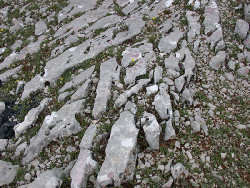Limestone Pavements

 Burren,
Burren,  Ireland.
Ireland.
 Turkey.
Turkey.Dissolution effects produce limestone pavements. They look very similar to karren, but they are formed along cracks or fissures in the limestone. In this case the water enters the crack and does not stay on the surface. The dissolution continues inside the crack, which gets wider and wider. At least until the water has dissolved enough limestone to be saturated.
The fissures are originally produced by tectonic movements. A force in one direction typically produces many parallel fissures. Sometimes also secondary fissures are formed in a certain angle to the primary fissures, typically 45°. Even if this is not the case, it is most likely that there were a few events, each causing cracks in one direction. The result is a pattern with cracks in two or three main directions. Each direction shows one stage in the tectonic history of the limestone.
When rainwater reaches the limestone surface, it dissolves limestone. The surface of karst areas lowers continually. When it reaches a crack it flows into the crack, dissolving on both sides and widening the crack. The cracks become clefts, the limestone is cut into blocks. This happens in areas with vegetation (covered karst) but is much more spectacular in bare karst. The limestone surface it cut into pavements. Limestone with two main directions of cracks, with an angle of about 90° in between, makes the typical limestone pavement, looking like an enormous chess board.
- Examples
 The Burren in Ireland.
The Burren in Ireland.
 Prof. Albert Heim (1877): Ueber die Karrenfelder
Prof. Albert Heim (1877): Ueber die Karrenfelder Search DuckDuckGo for "Limestone Pavement"
Search DuckDuckGo for "Limestone Pavement" Limestone pavement - Wikipedia
Limestone pavement - Wikipedia Karren
Karren
 Index
Index Topics
Topics Hierarchical
Hierarchical Countries
Countries Maps
Maps